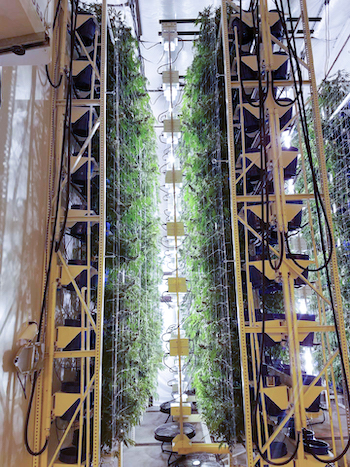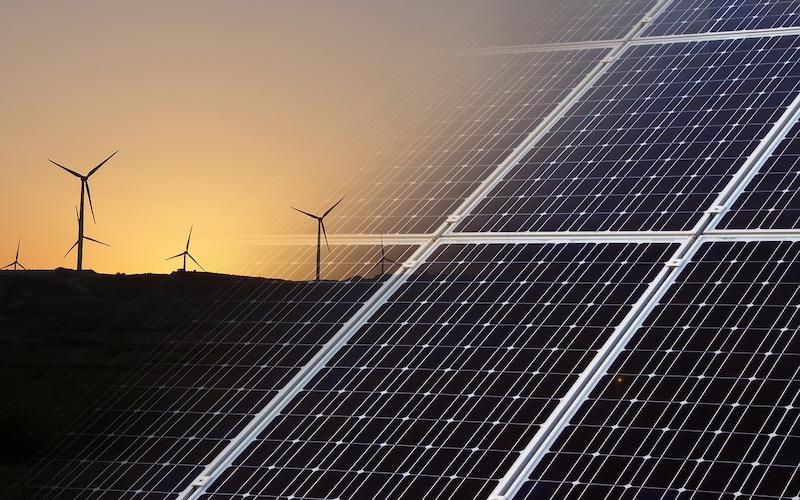For growing cannabis, indoor operations have become the norm. They’re discreet and owners can precisely control the climate – and their product. When strains have different THC contents and a quality product is the top priority, these indoor operations provide business owners the control they need to develop the exact product their customers want.
However, these facilities also come with extra costs. Space is limited, climate control equipment requires maintenance, and indoor lighting uses a lot of power. Different strategies and technologies can be employed to create a more efficient and sustainable grow operation. The upfront costs may be higher, but if you are willing to let technology take the wheel, the long-term benefits can outweigh the costs.
Related: How to Grow Greener with The Cannabis Conservancy’s Jacob Policzer

Vertical Growing
An easy way to make your grow operation more efficient is to expand up, rather than out. Vertical growing is a popular trend in the cannabis industry that allows for a more environmentally and financially sustainable operation.
“I believe the future of this industry will soon be transitioning to incorporate vertical growing to help maximize square footage while decreasing your carbon footprint,” said Mike Caine, master grower for Ideal Harvest and a past Cannabis Cup Winner. He should know too, as Ideal Harvest is one of the leading vertical grow consultants and providers in the industry.
The benefits, as highlighted by Ideal Harvest CEO Sheryl Mizicko, are many. From an energy standpoint, vertical growing allows you to use one light for two canopies, rather than just one. It also allows for less energy-intensive bulbs, replacing 1000W bulbs with 615-630W options. It also reduces water usage by using drip irrigation and water reclamation strategies.
Additionally, there is a convenience of access; vertical canopies can be serviced and maintained without having to reach into or over the canopy. This helps mitigate pests (mites, mold, bacteria) by reducing human-introduced elements. Prevention on the front end means less need for pesticides later on.
Apart from environmental benefits, vertical canopies can help the operation and business as a whole run more efficiently. With vertical, one person can service the same area in one-half day that it takes two people to do in an entire day. Additionally, fewer pesticides and organic indoor growing help create a better end product, meaning a more satisfied customer.
Automation
“Cannabis, as any other plant, needs a certain temperature, humidity level, and radiation level in order to grow in the most productive way.” This is according to Pieter Kwakernaak, General Manager of Hoogendoorn America, a leader in cannabis and horticulture automation.
Climate control is a major key to indoor cannabis growth. Like any plant, cannabis has specific needs that will determine the highest-quality harvest. “Where are they growing best in outside conditions?” Kwakernaak posed. “India or Jamaica, where it’s very high temperatures. That means in a growing environment, in a greenhouse or in an enclosed room, we mimic the same temperatures where the plant really thrives.”
The best way to achieve this balanced climate control is via automation; a system that monitors and adjusts based on the plant’s needs. In Hoogendoorn’s case, “We do a combination of temperature, humidity, and controlling the light levels,” Kwakernaak explained. “So, on the one hand, that means on a very bright, sunny summer day, we black out the greenhouse in order to mimic shorter days, so that the cannabis can start flowering. On the other hand, we’re also keeping in account that we control the humidity levels because you want to prevent mold in the flowers.”
It’s a delicate process, but one that will likely make or break your grow operation. “I would say the climate, the exact growing climate, is key to success or failure,” Kwakernaak claimed. “If you don’t have the right climate, with too high humidity levels, with too big temperature and humidity swings, then it’s a recipe for disaster, because then the plants are susceptible to diseases. They don’t grow well … It is all about balance … Your relative humidity has to be in balance with CO2, temperature, and radiation. Those four factors all play together in having the ideal climate for the plant.”
Related: 6 Tips for Designing Sustainable Commercial Grow Rooms
Energy
Growing cannabis is energy-intensive. According to MarketWatch, cannabis indoor grow operations account for one percent of electricity consumption in the U.S., approximately 40.3 million kWh per year. To power the lights and climate control systems, these facilities need a lot of power. “They use a lot of energy in a small footprint,” explained John Ryan, head of the financing division at Baker Energy Team. It was cannabis’ energy needs that made it perfect for Baker.
“We focus on the high energy users,” Ryan explained. “We have the ability to go in there and save them at least 10 percent on their current rate … It’s been in the neighborhood of 15 to 20 percent.” Baker works with their partners to develop alternate energy solutions, whether that be solar or wind power, cogeneration, or the development of micro-grids. “What we do is go in and customize the system to the customer’s needs,” Ryan continued. “We’re not out there with a truck full of solar panels … unless you need them. Ultimately, we’ll look at the project … As a rule of thumb, one megawatt of power needs five acres of land. Sometimes you just don’t have that amount of land to do a solar farm, so what we could do is, we’ll come in and do cogeneration and then utilize the rooftops for as much solar as we can.”
In a time when huge companies like Budweiser and a number of automobile makers are shifting their focus toward sustainability, namely cleaner energy, cannabis has the unique opportunity, as a young industry, to brand itself as sustainable. Utilizing alternative energy solutions won’t just benefit the bottom line, but could make cannabis companies champions of sustainability.
Cooling Systems
It’s already been established that a successful grow operations needs rigorous climate control equipment. But how can that equipment be more sustainable? Industrial chillers play a major role in temperature regulation for indoor operations. “The need for temperature control can cross your day in so many ways,” explained Philip Preston, president of PolyScience, manufacturer of liquid temperature control solutions. “It’s an extremely broad range of applications.”
However, these chillers can have an adverse effect on the environment, using valuable energy resources and releasing greenhouse gases in the process. For this reason, PolyScience developed their latest DuraChill line of chilling technology. The new series uses a natural and nontoxic refrigerant-grade propane which can regulate the temperature of your operation, without emitting ozone-depleting greenhouse gases.
The equipment chosen to run a grow operation will ultimately determine the sustainability of said facility – and the owner’s bottom line.
Feature Image by seagul from Pixabay
Author
-
Alex Moersen is an Associate Editor at Cannabis & Tech Today, covering pop culture, science and technology, business, legislation, and much more. Twitter: @yaboii_shanoo






